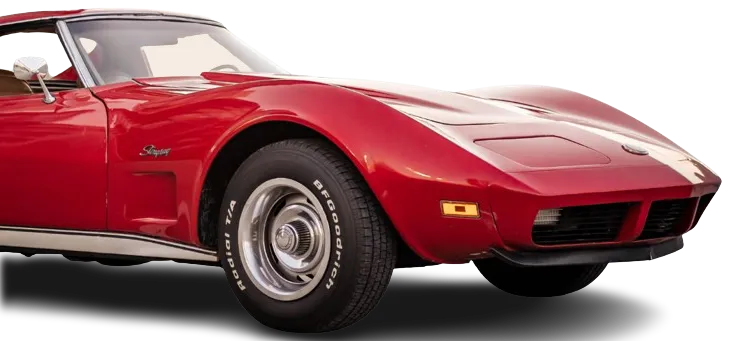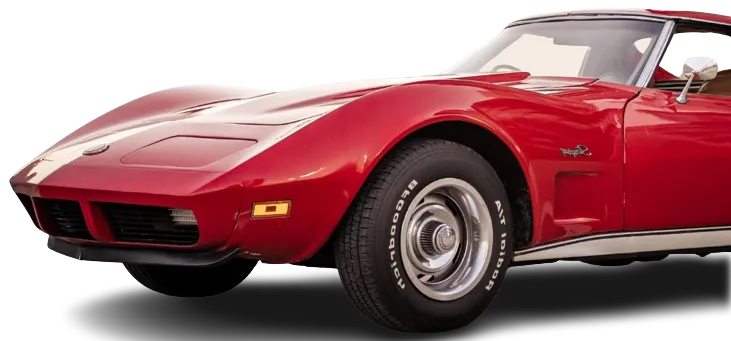Pontiac Tempest (1964)
PontiaC Tempest (1964)
Created thanks to one of the most controversial persons in the automotive world, the Tempest started the muscle car revolution and thus marked automotive history.
SPECIFICATION:
Start of production: 1960
Engines:
215 cu in (3.5 l), six cylinder
230 cu in (3.8 l), six cylinder
326 cu in (5.3 l), V8
389 cu in (6.4 l), V8
Transmissions:
2 – speed automatic
3 – speed automatic
3 – speed manual
4 – speed manual
Fuel consumption: 21.7 mpg (min)
Top speed: 100 (min)
Fun fact: An unproven racer
In 1962, Pontiac brought out the Le Mans variant – even smaller and sportier than the standard Tempest with an attractively redesigned interior.
But Pontiac also wanted a model that could compete at the top level of stock car racing, especially at the all-important NASCAR events. The company, therefore, also built a Super Duty Tempest Le Mans, a more rugged version of the car. Unfortunately, soon after this, parent company General Motors decided to withdraw from all racing activities.

Created thanks to one of the most controversial persons in the automotive world, the Tempest started the muscle car revolution and thus marked automotive history.
SPECIFICATION:
Start of production: 1960
Engines:
215 cu in (3.5 l), six cylinder
230 cu in (3.8 l), six cylinder
326 cu in (5.3 l), V8
389 cu in (6.4 l), V8
Transmissions:
2 – speed automatic
3 – speed automatic
3 – speed manual
4 – speed manual
Fuel consumption: 21.7 mpg (min)
Top speed: 100 (min)
Fun fact: An unproven racer
In 1962, Pontiac brought out the Le Mans variant – even smaller and sportier than the standard Tempest with an attractively redesigned interior.
But Pontiac also wanted a model that could compete at the top level of stock car racing, especially at the all-important NASCAR events. The company, therefore, also built a Super Duty Tempest Le Mans, a more rugged version of the car. Unfortunately, soon after this, parent company General Motors decided to withdraw from all racing activities.

The 1960s and 1970s in the USA were defined by the reign of muscle cars - arguably the most iconic product of the American automotive industry, whose popularity endures decades later. Among these legends, the Pontiac Tempest stands out as a pioneer.
The Pontiac Tempest was first introduced in 1960, under the lights of the Paris Motor Show.
Although it had its premiere in Europe, the design and dimensions of the car were tailored to the taste of USA buyers, where it gained great popularity in a short time. A year later it was named Motor Trend's Car of the Year.
This car was made according to a simple recipe devised by the chief engineer of the Pontiac division – today unfortunately remembered for numerous scandals, and not as the creator of the first muscle car - John DeLorean. His idea was to make a compact and light car with a powerful engine and an acceptable price so that it would be a favorite among young drivers. The most important ingredients were cheap components. Pontiac was part of the powerful General Motors (GM) group which also included Oldsmobile, Chevrolet, and Buick with whom the Tempest shared various parts to keep costs down. Added to that a new eye-catching design, independent suspension for a smooth ride, and fuel economy, you got a real treat.
In 1964, the second generation saw the light of day, completely redesigned and noticeably larger. There were different body variants on offer – from practical station wagons, and 4-door sedans that offered a unique dose of luxury, all the way to sports coupes. Customers could also choose between three trims: base Tempest, Tempest Custom, and Tempest Le Mans.
But the most sought-after among enthusiasts was the GTO model. This spectacular car grew out of a decision by parent company General Motors to ban its various divisions from being involved in competitive racing. General Motors had also forbidden its companies from using any engine greater than 329 cu in on a medium-sized car frame. This was a major blow to Pontiac, in particular, which was closely tied into the auto-racing world as part of its image and promotional strategies. Several senior Pontiac people, including John DeLorean, decided they would, therefore, produce mighty Pontiac "muscle cars" but focus on the performances their cars could achieve on the streets. The 1964 GTO was the first result.
The GTO was a Tempest Le Mans with an extra package equipped with a 389 cu in engine. Pontiac successfully bent the rules by making the vastly bigger engine an optional extra, rather than part of the standard fitting, but as it was offered at only $300 it was an option that everyone wanted. The name GTO stood for the Italian phrase "Gran Turismo Omologato," meaning a Grand Tourer car that was officially certified for racing. Of course, that was not true of the Pontiac – but anyway, they were only initials. Interestingly, although Pontiac advertised it as the "GTO Tiger" it was known to young drivers as the Goat.
When it launched in 1964, the GTO had surprised even Pontiac with the level of its sales, with more than 32,000 units leaving the showroom. Although the price was kept down to an affordable $4,500 it was still considered an exclusive car. Two years later GTO had a big makeover that increased sales to 96.946 cars. This was not only the GTO's highest annual sales figure, it was the most any muscle car had ever sold in one year. It was the golden age of muscle cars.
From 1966 the GTO was available as a model in its own right. With its new design this model has become known as the "Coke-bottle look," – a style that involved the car having (or giving the visual impression of) a body with a narrow center along with emphasized tail fins that suggested a flashy, more youthful style.
The Pontiac GTO has gone down in history as one of the finest muscle cars ever made. Some people even regard it as the first genuine muscle car, even though the term had been around for some time.
The 1960s and 1970s in the USA were defined by the reign of muscle cars - arguably the most iconic product of the American automotive industry, whose popularity endures decades later. Among these legends, the Pontiac Tempest stands out as a pioneer.
The Pontiac Tempest was first introduced in 1960, under the lights of the Paris Motor Show.
Although it had its premiere in Europe, the design and dimensions of the car were tailored to the taste of USA buyers, where it gained great popularity in a short time. A year later it was named Motor Trend's Car of the Year.
This car was made according to a simple recipe devised by the chief engineer of the Pontiac division – today unfortunately remembered for numerous scandals, and not as the creator of the first muscle car - John DeLorean. His idea was to make a compact and light car with a powerful engine and an acceptable price so that it would be a favorite among young drivers. The most important ingredients were cheap components. Pontiac was part of the powerful General Motors (GM) group which also included Oldsmobile, Chevrolet, and Buick with whom the Tempest shared various parts to keep costs down. Added to that a new eye-catching design, independent suspension for a smooth ride, and fuel economy, you got a real treat.
In 1964, the second generation saw the light of day, completely redesigned and noticeably larger. There were different body variants on offer – from practical station wagons, and 4-door sedans that offered a unique dose of luxury, all the way to sports coupes. Customers could also choose between three trims: base Tempest, Tempest Custom, and Tempest Le Mans.
But the most sought-after among enthusiasts was the GTO model. This spectacular car grew out of a decision by parent company General Motors to ban its various divisions from being involved in competitive racing. General Motors had also forbidden its companies from using any engine greater than 329 cu in on a medium-sized car frame. This was a major blow to Pontiac, in particular, which was closely tied into the auto-racing world as part of its image and promotional strategies. Several senior Pontiac people, including John DeLorean, decided they would, therefore, produce mighty Pontiac "muscle cars" but focus on the performances their cars could achieve on the streets. The 1964 GTO was the first result.
The GTO was a Tempest Le Mans with an extra package equipped with a 389 cu in engine. Pontiac successfully bent the rules by making the vastly bigger engine an optional extra, rather than part of the standard fitting, but as it was offered at only $300 it was an option that everyone wanted. The name GTO stood for the Italian phrase "Gran Turismo Omologato," meaning a Grand Tourer car that was officially certified for racing. Of course, that was not true of the Pontiac – but anyway, they were only initials. Interestingly, although Pontiac advertised it as the "GTO Tiger" it was known to young drivers as the Goat.
When it launched in 1964, the GTO had surprised even Pontiac with the level of its sales, with more than 32,000 units leaving the showroom. Although the price was kept down to an affordable $4,500 it was still considered an exclusive car. Two years later GTO had a big makeover that increased sales to 96.946 cars. This was not only the GTO's highest annual sales figure, it was the most any muscle car had ever sold in one year. It was the golden age of muscle cars.
From 1966 the GTO was available as a model in its own right. With its new design this model has become known as the "Coke-bottle look," – a style that involved the car having (or giving the visual impression of) a body with a narrow center along with emphasized tail fins that suggested a flashy, more youthful style.
The Pontiac GTO has gone down in history as one of the finest muscle cars ever made. Some people even regard it as the first genuine muscle car, even though the term had been around for some time.
Under the Hood
Different engines could be found under the hood - from “economical” ones to those that ripped the tires of the rear wheels. Typical of the second generation (1964 - 1967), the smallest in the range was the in-line 6-cylinder 215 cu in (3.5l) engine with 140 hp. Certainly far more attractive were the V8 engines - smaller 326 cu in (5.3l) and the mentioned 389 cu in (6.4l).
The biggest engine was also the most desirable. This brutal machine with 348 hp, a special camshaft, and a valve lifter, allowed for astonishing performance. The Tempest could accelerate from 0-60 mph in 6 seconds, and in the next 10, it had covered a quarter mile.
Automatic and manual gearboxes with 2, 3, or 4 speeds were offered. Unlike the first generation, the Tempest from 1964 used a traditional layout - the engine and transmission were placed longitudinally in the front, and the drivetrain was in the rear.


Exterior
The bodywork was designed in the spirit of typical American cars of the time, with the intention of attracting primarily young drivers. There were different body styles on offer so that everyone could choose a Tempest according to their taste and needs.
Of course, the GTO variant with distinctive dual exhausts, special, dual hood scoops, and GTO nameplates stood out here as well. Such a bodywork was very attractive, especially when riding on shiny chrome wheels.

Under the Hood
Different engines could be found under the hood - from “economical” ones to those that ripped the tires of the rear wheels. Typical of the second generation (1964 - 1967), the smallest in the range was the in-line 6-cylinder 215 cu in (3.5l) engine with 140 hp. Certainly far more attractive were the V8 engines - smaller 326 cu in (5.3l) and the mentioned 389 cu in (6.4l).
The biggest engine was also the most desirable. This brutal machine with 348 hp, a special camshaft, and a valve lifter, allowed for astonishing performance. The Tempest could accelerate from 0-60 mph in 6 seconds, and in the next 10, it had covered a quarter mile.
Automatic and manual gearboxes with 2, 3, or 4 speeds were offered. Unlike the first generation, the Tempest from 1964 used a traditional layout - the engine and transmission were placed longitudinally in the front, and the drivetrain was in the rear.

Exterior
The bodywork was designed in the spirit of typical American cars of the time, with the intention of attracting primarily young drivers. There were different body styles on offer so that everyone could choose a Tempest according to their taste and needs.
Of course, the GTO variant with distinctive dual exhausts, special, dual hood scoops, and GTO nameplates stood out here as well. Such a bodywork was very attractive, especially when riding on shiny chrome wheels.
Interior
The interior also featured parts borrowed by the Tempest from its GM cousins. For example, the so-called bucket seats. in the GTO are the same as those in the Chevrolet Corvair Monza.
The interior is practical and everything is in its place. The instruments are all properly arranged and readable, although some drivers complain about the tachometer, which is too small and far from the eyes. The Tempest also featured air conditioning, radio, windshield washers, and other details that added to the luxury feel.
What particularly delights is the position behind the wheel. The driver sits in something reminiscent of bucket seats, but to be honest, they are just classically separated seats with slightly pronounced lateral support, which represent an ideal compromise between sporty driving and comfort. The driver's hand ideally falls on the gear lever ideally positioned next to the thigh.
The front seats are comfortable and offer enough space, but the same cannot be said for those in the second row. The rear seats offer enough space for two adult passengers, but with a third, it becomes too tight - so much so that they will bump into each other's shoulders. But hand on heart it's not a problem as long as it's about good friends.
What it's like to drive a Tempest
Driving the Tempest is a special experience that no muscle car fan should miss. As expected, performance is at an enviable level, especially for models with V8 engines. The intermediate accelerations are really fascinating. It is enough for the driver to press the gas pedal all the way, and the violent torque (428 lb-ft @ 3600 rpm) will make his legs instantly lighter and his back pushed to the seat.
This is exactly what is expected from real muscle cars, which are named that because of the high torque, and not the horsepower stable under the hood, as some mistakenly think.
“No great car was ever done by a group. Almost all the great cars in the world that you know about were individual efforts.”
-John Delorean
Interior
The interior also featured parts borrowed by the Tempest from its GM cousins. For example, the so-called bucket seats. in the GTO are the same as those in the Chevrolet Corvair Monza.
The interior is practical and everything is in its place. The instruments are all properly arranged and readable, although some drivers complain about the tachometer, which is too small and far from the eyes. The Tempest also featured air conditioning, radio, windshield washers, and other details that added to the luxury feel.
What particularly delights is the position behind the wheel. The driver sits in something reminiscent of bucket seats, but to be honest, they are just classically separated seats with slightly pronounced lateral support, which represent an ideal compromise between sporty driving and comfort. The driver's hand ideally falls on the gear lever ideally positioned next to the thigh.
The front seats are comfortable and offer enough space, but the same cannot be said for those in the second row. The rear seats offer enough space for two adult passengers, but with a third, it becomes too tight - so much so that they will bump into each other's shoulders. But hand on heart it's not a problem as long as it's about good friends.
What it's like to drive a Tempest
Driving the Tempest is a special experience that no muscle car fan should miss. As expected, performance is at an enviable level, especially for models with V8 engines. The intermediate accelerations are really fascinating. It is enough for the driver to press the gas pedal all the way, and the violent torque (428 lb-ft @ 3600 rpm) will make his legs instantly lighter and his back pushed to the seat.
This is exactly what is expected from real muscle cars, which are named that because of the high torque, and not the horsepower stable under the hood, as some mistakenly think.
“No great car was ever done by a group. Almost all the great cars in the world that you know about were individual efforts.”
-John Delorean

Have Questions About Renting A Car?
+1 813-531-9481


Have Questions About Renting A Car?
813-699-9428

Copyright © 2024 Eternity Luxury Group. All Rights Reserved.
LOCATIONS
Tampa
COMING SOON
COMING SOON
COMING SOON
Copyright © 2024 Eternity Luxury Group. All Rights Reserved.

